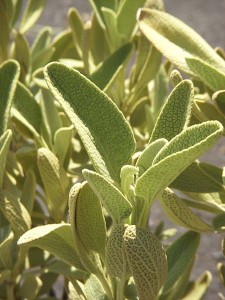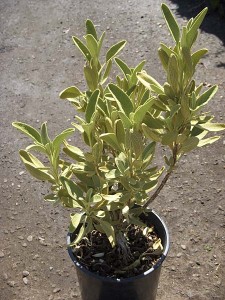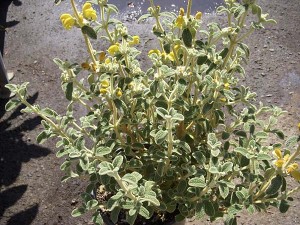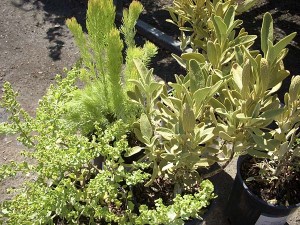It’s not quite planting season, but for the last few trips to the local nursery I’d been eying a plant I hadn’t noticed before, Phlomis monocephala, a sister species to the more common Jerusalem sage, P. fruticosa.
This strongly drought-tolerant species from Turkey has leaves that are highly textured like those of several native California sages. What sets it apart from the California sages is what it does in the summer, when the leaves turn this strong yellow-green color. In the spring to early summer it will have a modest display of yellow flowers, but this a plant that you use for its cool foliage, providing a point of interest when a lot of the natives have shut down.
My front yard is a mixed Mediterranean-climate planting with a number of California natives, and I thought this plant would complement them nicely. It so happens that there are some plants that peaked five years ago and would better replaced. Three phlomis would fit in their spot perfectly.
It so happened that the nursery had exactly three plants. Plant shopping can be a competitive sport. If you see something, that might be the last chance you’ll have at it. So you can probably guess that I’m now the owner of three little Phlomis monocephala plants. I won’t do any serious garden reworking for another month or so, but I should be able to keep the plants happy and watered for that long.
The plant will top out at about four by four feet, is considered hardy to zone 9, and requires excellent drainage.
While at the nursery I noticed this other California-friendly phlomis, P. lanata. This species grows lower, to maybe two feet tall by three to four wide. The size and shape of the plant actually would have been a better choice for the spot I have, but this isn’t one of the phlomis species that develops the gorgeous yellow summer coloration.
What it does have, though, are these really cool, fuzzy grayish leaves and stems. How can you resist touching it? Like the much larger Jerusalem sage, it’ll put on a good show of bright yellow flowers.
One thing I do at nurseries is to move plants into little combinations to see how they’d look together. The first time the staff sees me doing it it might raise some eyebrows, but the staff at Walter Anderson Nursery is used to me by now. (As you might expect someone who works in a library, I make sure to put everything back in its proper place.)
Here’s a play in scale and texture, a little ensemble of yellowish-green to pale green colored leaves that I liked: the Phlomis monocephala that I bought, in combination with what would be the low-growing form of coyote bush brush (Baccharis pilularis pilularis ‘Pigeon Point’) and the really delicate Australian woolly bush (Adenanthos sericeus).
Often, when you do an exercise like this, the plants will have wildly different cultural requirements or would be grossly incompatible size-wise. But in this case all three could coexist together in a nice planting, with maybe only the woolly bush needing just a bit more summer watering. The woolly bush would grow up into a large shrub, the phlomis into a dense medium-sized one, and the coyote bush brush would sprawl attractively around the base of the other two.





I’ve not seen this before though I’ve heard of phlomis. It looks like a nice plant and I think it great you are so aware of the drought conditions out there in California and plan for working with that instead of against it in your garden.
James,
It’s official: I’ve tagged you for a Meme Award … do drop by to pick it up!
Cheers,
Alice
Nice plants you have picked out there James. I also get all the plants out that I am thinking of buying and try the various combination’s its a really helpful thing to do.
K
I love the combination & have had much luck with Adenanthos.
Mmmmm, I do like the sage foliage. Recognized it right off. Thanks for reminding me I need more of that.
Ha ha…I love you rearranging pots at the nursery. Cool idea. I can see where the staff might be worried at first, though.
Tina, at this point all the front yard plants should get by with very little summer water–It limits the choices when shopping, but nurseries around here are stepping up with lots of interesting options.
Alice, gosh I’m flattered! Thank you thank you.
Karen, there are people who can pre-imagine combinations that look perfect together, but I really enjoy moving plants around and playing with relationships.
Susie, glad to hear you’ve done well with adenanthos. I suspect that one of these years I’ll make room for it!
Greg, up close this phlomis looks like a dead ringer for culinary sage, same shape and size and texture, though the color is a little tweaked. Too bad, though, that it’s not fragrant like the sages.
Thanks for the information! California is facing a water shortage and California-friendly plants add beauty to the garden while they also help in efficient water use. Visit http://bit.ly/n8Okj for water-wise gardening tips.
Hi, fellow San Diego gardener — I discovered your great site while researching Adenanthos Sericeus. Our recent monsoon has my 6 foot tall Wooly Bush flopping over. I’ve staked it up, and was wondering if it was safe to prune it a little. The only thing I’ve been able to find on the web is that “tip pruning” is OK, but that it is not happy with much pruning. It is notoriously shallow rooted, and I’m concerned that it will fall completely over. I love this shrub and don’t want to lose it. Any experience or suggestions?
Hi Cynthia, I’ve coveted this plant but never grown it, so my knowledge of it is somewhat limited. Second hand information does talk about the shallow root system you mention, but I only encountered one report of the plant toppling. They’re routinely used for hedges and for florist foliage, so my guess is that they can stand at least a gentle to moderate pruning. (I can’t imagine any hedge plant that couldn’t stand up to a little lopping.)
I know that one of my fellow California bloggers has discussed a plant she has, and I’ll see if I can’t find who that is. In the meantime, it might be interested to inquire of some of the many Australian bloggers who grow it. Ockam’s Razor is one (http://ockhamsrazor.wordpress.com/).